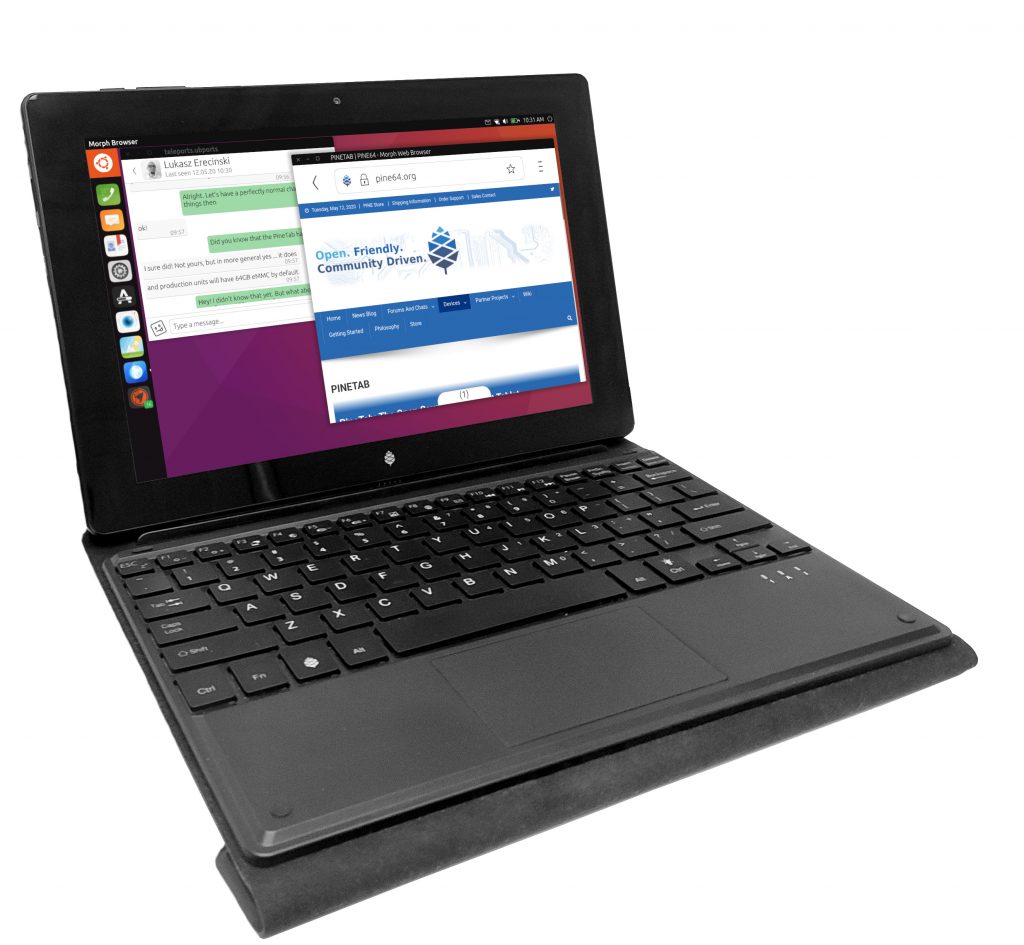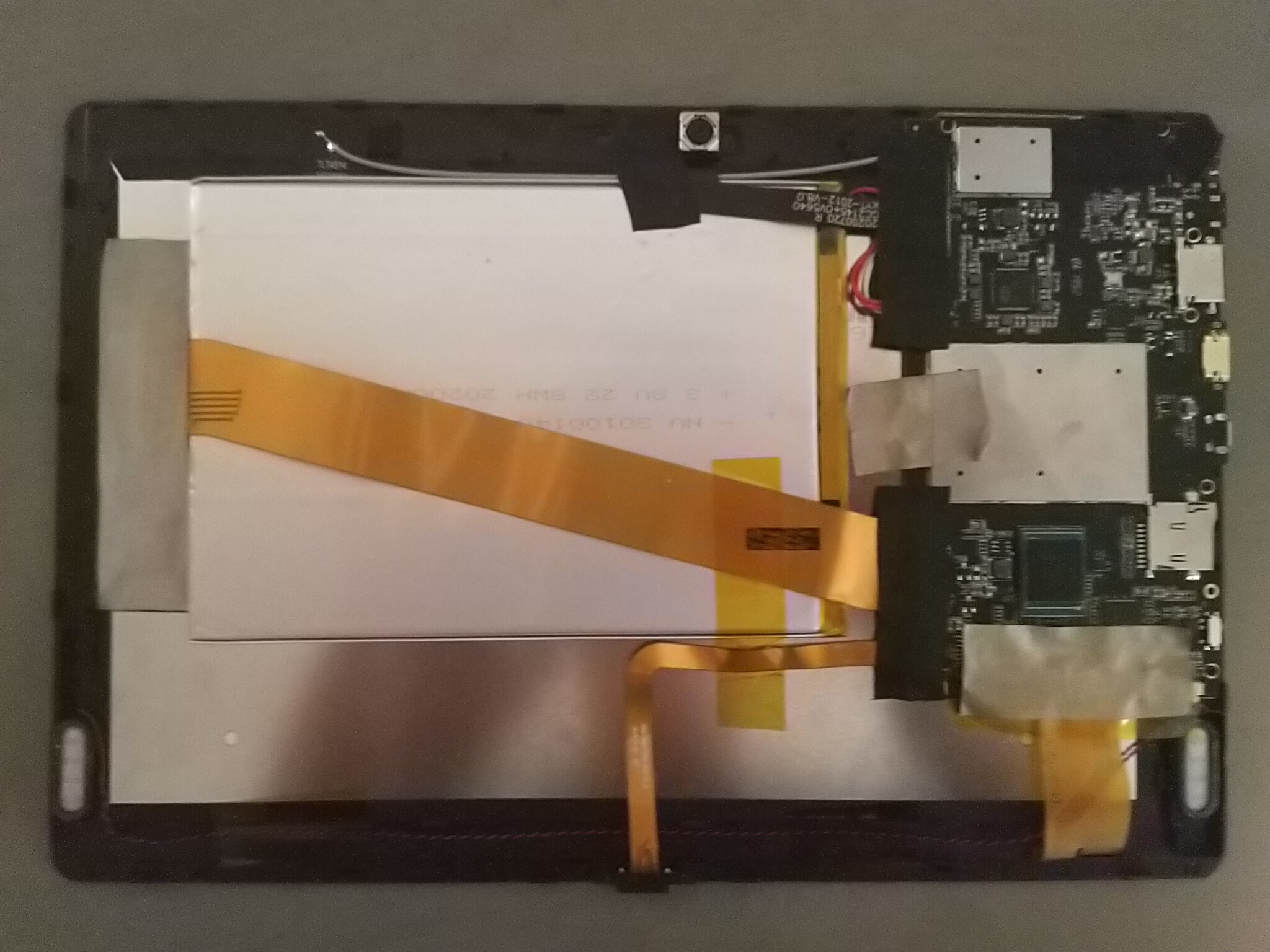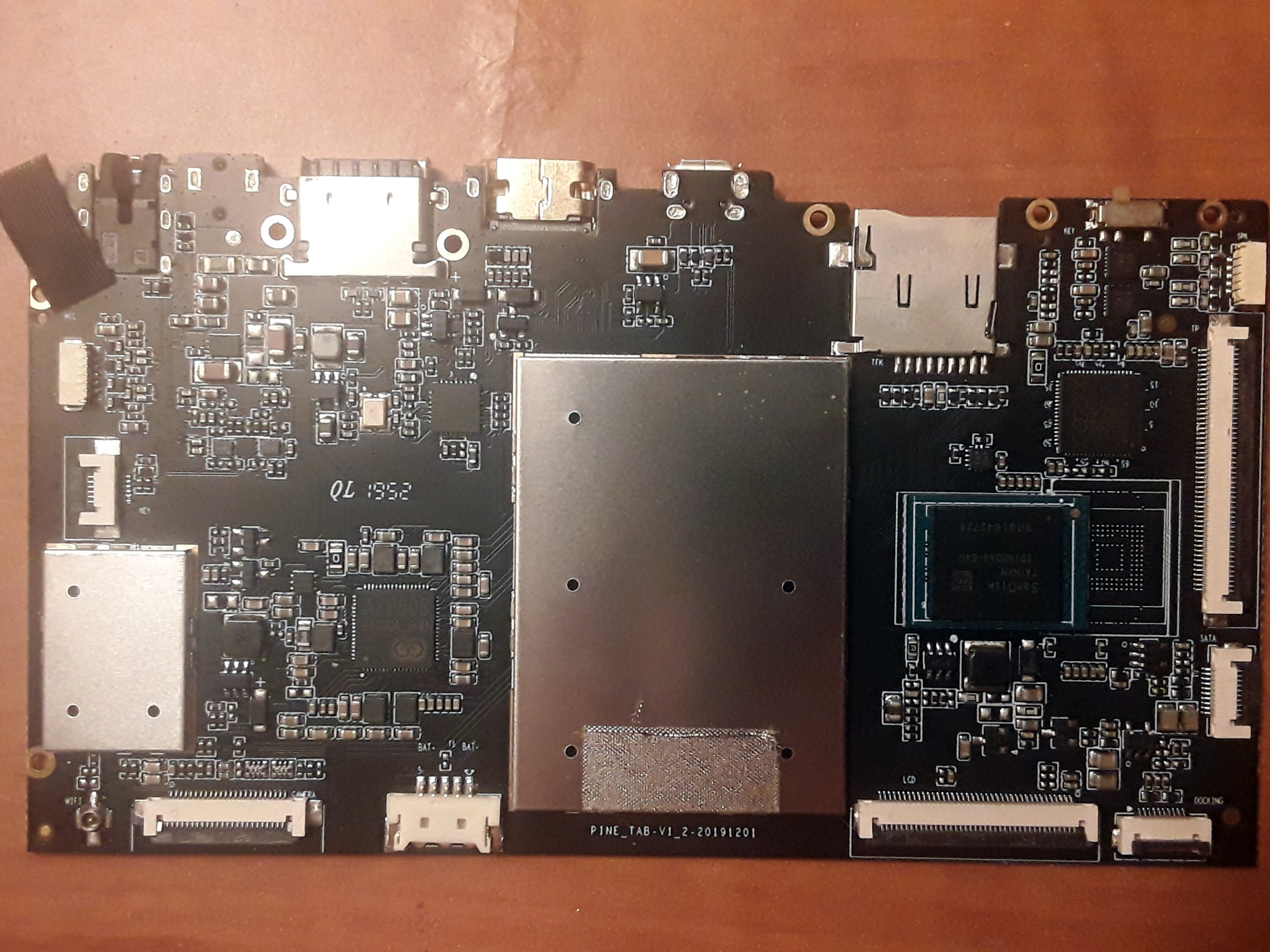Difference between revisions of "PineTab"
(Add note about disabling sleep.) |
(→Operating Systems: Split PineTab releases off from PineTab page) |
||
| (56 intermediate revisions by 15 users not shown) | |||
| Line 1: | Line 1: | ||
[[File:Pinetab.jpg|400px|thumb|right|The PineTab]] | |||
The PineTab is a 10" tablet created by | The '''PineTab''' is a 10" tablet created by PINE64. The PineTab is similar in both form, function and underlying ARM64 architecture to the original 11.6″ Pinebook. It is powered by the same quad-core ARM Cortex A53 64-Bit Processor used in our popular PINE A64 Single Board Computer. The optional keyboard and trackpad – which doubles-up as a screen cover – effectively converts the PineTab into a petite on-the-go laptop with a touch screen functionality. It runs numerous mainline Linux distributions as well as *BSD and Android. | ||
Superseded by [[PineTab2]]. | |||
== Revisions == | |||
* Developer Edition - development version sent to roughly 100 developers. Close to the Early Adopter Edition, but with a different display panel | |||
* [[PineTab/Early-Adopter|Early Adopter Edition]] - the first hardware revision of the PineTab | |||
[[File:PineTabBoard.jpeg|400px|thumb|right|The insides of the PineTab]] | |||
[[File:PineTab_Board.jpg|thumb|right|Pinetab Board]] | |||
== Specifications == | == Specifications == | ||
| Line 17: | Line 27: | ||
* '''RAM:''' 2GB LPDDR3 | * '''RAM:''' 2GB LPDDR3 | ||
* '''I/O:''' HD Video Out (Mini HDMI), Micro USB 2.0 OTG, USB 2.0 A host, 3.5mm Headphone/Mic combo, | * '''I/O:''' HD Video Out (Mini HDMI), Micro USB 2.0 OTG, USB 2.0 A host, 3.5mm Headphone/Mic combo, | ||
* '''Network''' | * '''Network:''' | ||
** WiFi (802.11b/g/n, 2.4GHz only) | ** WiFi (802.11b/g/n, 2.4GHz only) | ||
** Bluetooth 2.1 | ** Bluetooth 2.1 | ||
** M.2 LTE / Cell MODEM card, (optional, and takes place of optional M.2 SSD) | ** M.2 LTE / Cell MODEM card, (optional, and takes place of optional M.2 SSD) | ||
* ''' | * '''Display:''' | ||
** '''Size:''' 10.1 inches (257mm) diagonal | |||
** '''Type:''' HD IPS capacitive touchscreen, 16M colors | |||
** '''Resolution:''' 1280x800, 16:10 ratio <br> | |||
* '''Attachments/Accessories:''' Magnetically attached keyboard (optional) | * '''Attachments/Accessories:''' Magnetically attached keyboard (optional) | ||
* '''Battery:''' 6000MAh (6Ah) | * '''Battery:''' 6000MAh (6Ah) | ||
* '''Misc. features:''' | * '''Misc. features:''' | ||
** Volume rocker | ** Volume rocker | ||
** Speakers and Microphone | ** Speakers and Microphone | ||
** 2.5mm OD 0.7mm ID DC Jack Power (5V 2A) Port | ** 2.5mm OD 0.7mm ID DC Jack Power (5V 2A) Port | ||
| Line 32: | Line 45: | ||
'''Overview:''' The PineTab detachable keyboard features a full function row, FN key functionality, meta key (where the Windows key would be) and all of the keys you need for daily use. | '''Overview:''' The PineTab detachable keyboard features a full function row, FN key functionality, meta key (where the Windows key would be) and all of the keys you need for daily use. | ||
'''FN keys:''' | '''FN keys:''' Pause/play (F2), Stop (F3), Previous(F4), Next(F5), Music (F6), Mail (F7), Home (F8), Mute (F9), Vol- (F10), Vol+ (F11), Disable touchpad (F12), NumLock (Insert), Scroll Lock (Delete), PgUp (Up Arrow), PgDn (Down Arrow), Home (Left Arrow), End (Right Arrow), Digital Numpad (7,8,9,0,U,I,O,P,J,K,L,;,M,.,/) | ||
== | == Operating Systems == | ||
The PineTab will automatically boot from microSD if a bootable card is inserted. Although it is technically possible to use any ARM distro (because the PineTab uses the mainline kernel), only few of them will actually be usable on Early Adopters PineTab, due to specifics of working with LCD panel. | |||
[[ | Since most software issues will be release-specific, please see the [[PineTab Releases]] page for additional software related instructions, tips, and tricks. | ||
== | === Releases === | ||
The releases for the PineTab can be found under [[PineTab Releases]]. | |||
== | == Installation instructions == | ||
For instructions on how to install the operating systems to the eMMC or microSD card see [[PinePhone Installation Instructions]]. The information is almost the same for the PineTab, as it is a very similar device. Do not try to use the PinePhone images though, use the PineTab images linked above. | |||
For details see the [[Getting started]] article. | |||
== Tips and tricks == | |||
=== Reset === | |||
If your PineTab is in unknown state or doesn't want to start: Press power button for 7-8s. It makes a sound and you know it's totally off. 3 seconds after, power button again for 2-3s and it will start to boot. | |||
=== Power Off While Charging === | |||
When plugging your Pinetab into a charger, it automatically powers on. Use the above "Reset" instruction (holding the power button in for several seconds) to turn it off. This will allow your Pinetab to charge without being powered on. | |||
=== Display rotated 90° on Arch ARM === | |||
With the following command you can turn the display to landscape: | |||
echo 1 | sudo tee /sys/class/graphics/fbcon/rotate | |||
This command does not persist a reboot. | |||
== | == Assembly and disassembly == | ||
It | Be very careful here. It is not a 'pop off' cover design. | ||
Special care should be directed to AVOID anything that may appear to cause a "bend" in screen. | |||
Gently use fingernails (or if you have one, plastic pry), starting in the very middle location for each side (saving keyboard connector latch over area (bottom side) for the very last removal step). | |||
Work your way from the inner middle on each side, slowly. Slide gently towards the direction of each corner (saving the lifting of actual corners themselves for the second to last step)). Careful not to break thin speaker wires that line the outside of the inner case. | |||
The very last opening piece should be the "latch over" (where the keyboard pins connect). | |||
KEEP IN MIND: The main key here is to avoid any potential "bend" of the screen. We save the corners until after working on the middle of each side to reduce pressure on the screen. | |||
Do not force anything. If it is not coming off with gentle effort, you are likely doing something wrong (try another side middle). | |||
== | == Board information, schematics and certifications == | ||
PineTab mainboard schematic: | |||
* [https://files.pine64.org/doc/PineTab/PineTab%20Schematic%20v1.2-20191125.pdf PineTab mainboard Released Schematic ver 1.2] | |||
* [https://files.pine64.org/doc/PineTab/PineTab%20Board%20View%20v1.2-20191201-top.pdf PineTab mainboard component placement ver 1.2 - Top View] | |||
* [https://files.pine64.org/doc/PineTab/PineTab%20Board%20View%20v1.2-20191201-bottom.pdf PineTab mainboard component placement ver 1.2 - Bottom View] | |||
PineTab keyboard schematic: | |||
[ | * PineTab keyboard and Pinebook (Pro) keyboard using same controller and from same engineering source | ||
* [https://files.pine64.org/doc/PineTab/Pinetab%20HB092A%20Keyboard%20Schematic.pdf PineTab Keyboard Schematic] | |||
* [https://files.pine64.org/doc/PineTab/HB092_0884232458_Hynitron_PTP_20200514_662905_Linux_US_BackLight_CRC_175057F5.hex PineTab keyboard firmware code] | |||
* [https://files.pine64.org/doc/PineTab/SH68F83V2.0.pdf PineTab Keyboard Controller Datasheet] | |||
PineTab certifications: | |||
* [https://files.pine64.org/doc/cert/PineTab%20FCC-SDOC%20Certificate-S20060600404001.pdf PineTab FCC Certificate] | |||
* [https://files.pine64.org/doc/cert/PineTab%20CE-RED%20Certificate-S20060600403.pdf PineTab CE RED Certificate] | |||
* [https://files.pine64.org/doc/cert/PINETAB%20ROHS%20TEST%20REPORT.pdf PineTab ROHS Test Report] | |||
== | == Datasheets for components and peripherals == | ||
[ | Allwinner A64 SoC information: | ||
* [https://files.pine64.org/doc/datasheet/pine64/A64%20brief%20v1.0%2020150323.pdf Allwinner A64 SoC brief introduction] | |||
* [https://files.pine64.org/doc/datasheet/pine64/A64_Datasheet_V1.1.pdf Allwinner A64 SoC Data Sheet V1.1 (Official Released Version)] | |||
* [https://files.pine64.org/doc/datasheet/pine64/Allwinner_A64_User_Manual_V1.0.pdf Allwinner A64 SoC User Manual V1.0 (Official Release Version)] | |||
X-Powers AXP803 PMU (Power Management Unit) information: | |||
* [https://files.pine64.org/doc/datasheet/pine64/AXP803_Datasheet_V1.0.pdf AXP803 PMIC datasheet] | |||
LPDDR3 (178 Balls) SDRAM: | |||
* [https://files.pine64.org/doc/datasheet/pinephone/ATL3A1632H12A_mobile_lpddr3_11x11.5_v1.0_1600.pdf Artmem LPDDR3 datasheet] | |||
eMMC information: | |||
* | * [https://files.pine64.org/doc/rock64/PINE64_eMMC_Module_20170719.pdf PINE64 eMMC module schematic] | ||
* [https://files.pine64.org/doc/rock64/usb%20emmc%20module%20adapter%20v2.pdf PINE64 USB adapter for eMMC module V2 schematic] | |||
* | * [https://files.pine64.org/doc/rock64/USB%20adapter%20for%20eMMC%20module%20PCB.tar PINE64 USB adapter for eMMC module PCB in JPEG] | ||
* [https://files.pine64.org/doc/datasheet/pine64/SDINADF4-16-128GB-H%20data%20sheet%20v1.13.pdf 64GB SanDisk eMMC Datasheet] | |||
* | |||
* | |||
CMOS camera module information: | |||
* [https://files.pine64.org/doc/datasheet/pinephone/OV5640_datasheet.pdf OV5640 5MP CMOS Image Sensor SoC for Rear Module datasheet] | |||
* [https://files.pine64.org/doc/datasheet/pinephone/GC2145%20CSP%20DataSheet%20release%20V1.0_20131201.pdf GC2145 2MP CMOS Image Sensor SoC for Front Module datasheet] | |||
LCD touch screen panel information: | |||
* [https://files.pine64.org/doc/datasheet/pinetab/GT9271.pdf GOODiX GT9271 Capacitive Touch Controller datasheet] | |||
* [https://files.pine64.org/doc/datasheet/pinetab/GT9271_Config_20200818_142030_V66.cfg PineTab GT9271 Capacitive Touch Controller configuration file] | |||
Lithium battery information: | |||
* N/A | |||
WiFi/BT module information: | |||
* [https://files.pine64.org/doc/datasheet/pine64/RTL8723BS.pdf RTL8723BS/RTL8723CS specification] | |||
* | == External Links == | ||
* [https://pine64.com/product/pinetab-10-1-linux-tablet/ The PineTab on the Pine64 store] | |||
* [https://forum.pine64.org/forumdisplay.php?fid=140 The PineTab section of the Pine64 forums] | |||
* [https://forum.pine64.org/showthread.php?tid=11401 Comments on back cover removal on forums] | |||
* [https://forum.pine64.org/showthread.php?tid=13118 Demonstration Video: Pinetab back cover removal on forums] | |||
[[Category:PineTab]] [[Category:Allwinner A64]] | [[Category:PineTab]] [[Category:Allwinner A64]] | ||
Latest revision as of 09:50, 9 December 2023
The PineTab is a 10" tablet created by PINE64. The PineTab is similar in both form, function and underlying ARM64 architecture to the original 11.6″ Pinebook. It is powered by the same quad-core ARM Cortex A53 64-Bit Processor used in our popular PINE A64 Single Board Computer. The optional keyboard and trackpad – which doubles-up as a screen cover – effectively converts the PineTab into a petite on-the-go laptop with a touch screen functionality. It runs numerous mainline Linux distributions as well as *BSD and Android.
Superseded by PineTab2.
Revisions
- Developer Edition - development version sent to roughly 100 developers. Close to the Early Adopter Edition, but with a different display panel
- Early Adopter Edition - the first hardware revision of the PineTab
Specifications
- Dimensions: 11mm x 175mm x 260mm (Thickness, Width, Height)
- Weight: 575g (Tablet alone)
- Build: Plastic
- Storage:
- 64GB of internal eMMC storage
- MicroSD slot, bootable
- M.2 SSD slot, supports SATA and USB devices only, not NVME (optional)
- Cameras: 2Mpx Front, 5Mpx Rear
- SOC: Allwinner A64 Quad Core
- CPU: 4x ARM A53 1.152GHz
- GPU: Mali 400 MP2
- RAM: 2GB LPDDR3
- I/O: HD Video Out (Mini HDMI), Micro USB 2.0 OTG, USB 2.0 A host, 3.5mm Headphone/Mic combo,
- Network:
- WiFi (802.11b/g/n, 2.4GHz only)
- Bluetooth 2.1
- M.2 LTE / Cell MODEM card, (optional, and takes place of optional M.2 SSD)
- Display:
- Size: 10.1 inches (257mm) diagonal
- Type: HD IPS capacitive touchscreen, 16M colors
- Resolution: 1280x800, 16:10 ratio
- Attachments/Accessories: Magnetically attached keyboard (optional)
- Battery: 6000MAh (6Ah)
- Misc. features:
- Volume rocker
- Speakers and Microphone
- 2.5mm OD 0.7mm ID DC Jack Power (5V 2A) Port
Keyboard
Overview: The PineTab detachable keyboard features a full function row, FN key functionality, meta key (where the Windows key would be) and all of the keys you need for daily use.
FN keys: Pause/play (F2), Stop (F3), Previous(F4), Next(F5), Music (F6), Mail (F7), Home (F8), Mute (F9), Vol- (F10), Vol+ (F11), Disable touchpad (F12), NumLock (Insert), Scroll Lock (Delete), PgUp (Up Arrow), PgDn (Down Arrow), Home (Left Arrow), End (Right Arrow), Digital Numpad (7,8,9,0,U,I,O,P,J,K,L,;,M,.,/)
Operating Systems
The PineTab will automatically boot from microSD if a bootable card is inserted. Although it is technically possible to use any ARM distro (because the PineTab uses the mainline kernel), only few of them will actually be usable on Early Adopters PineTab, due to specifics of working with LCD panel.
Since most software issues will be release-specific, please see the PineTab Releases page for additional software related instructions, tips, and tricks.
Releases
The releases for the PineTab can be found under PineTab Releases.
Installation instructions
For instructions on how to install the operating systems to the eMMC or microSD card see PinePhone Installation Instructions. The information is almost the same for the PineTab, as it is a very similar device. Do not try to use the PinePhone images though, use the PineTab images linked above.
For details see the Getting started article.
Tips and tricks
Reset
If your PineTab is in unknown state or doesn't want to start: Press power button for 7-8s. It makes a sound and you know it's totally off. 3 seconds after, power button again for 2-3s and it will start to boot.
Power Off While Charging
When plugging your Pinetab into a charger, it automatically powers on. Use the above "Reset" instruction (holding the power button in for several seconds) to turn it off. This will allow your Pinetab to charge without being powered on.
Display rotated 90° on Arch ARM
With the following command you can turn the display to landscape:
echo 1 | sudo tee /sys/class/graphics/fbcon/rotate
This command does not persist a reboot.
Assembly and disassembly
Be very careful here. It is not a 'pop off' cover design. Special care should be directed to AVOID anything that may appear to cause a "bend" in screen.
Gently use fingernails (or if you have one, plastic pry), starting in the very middle location for each side (saving keyboard connector latch over area (bottom side) for the very last removal step).
Work your way from the inner middle on each side, slowly. Slide gently towards the direction of each corner (saving the lifting of actual corners themselves for the second to last step)). Careful not to break thin speaker wires that line the outside of the inner case.
The very last opening piece should be the "latch over" (where the keyboard pins connect).
KEEP IN MIND: The main key here is to avoid any potential "bend" of the screen. We save the corners until after working on the middle of each side to reduce pressure on the screen.
Do not force anything. If it is not coming off with gentle effort, you are likely doing something wrong (try another side middle).
Board information, schematics and certifications
PineTab mainboard schematic:
- PineTab mainboard Released Schematic ver 1.2
- PineTab mainboard component placement ver 1.2 - Top View
- PineTab mainboard component placement ver 1.2 - Bottom View
PineTab keyboard schematic:
- PineTab keyboard and Pinebook (Pro) keyboard using same controller and from same engineering source
- PineTab Keyboard Schematic
- PineTab keyboard firmware code
- PineTab Keyboard Controller Datasheet
PineTab certifications:
Datasheets for components and peripherals
Allwinner A64 SoC information:
- Allwinner A64 SoC brief introduction
- Allwinner A64 SoC Data Sheet V1.1 (Official Released Version)
- Allwinner A64 SoC User Manual V1.0 (Official Release Version)
X-Powers AXP803 PMU (Power Management Unit) information:
LPDDR3 (178 Balls) SDRAM:
eMMC information:
- PINE64 eMMC module schematic
- PINE64 USB adapter for eMMC module V2 schematic
- PINE64 USB adapter for eMMC module PCB in JPEG
- 64GB SanDisk eMMC Datasheet
CMOS camera module information:
- OV5640 5MP CMOS Image Sensor SoC for Rear Module datasheet
- GC2145 2MP CMOS Image Sensor SoC for Front Module datasheet
LCD touch screen panel information:
- GOODiX GT9271 Capacitive Touch Controller datasheet
- PineTab GT9271 Capacitive Touch Controller configuration file
Lithium battery information:
- N/A
WiFi/BT module information:


